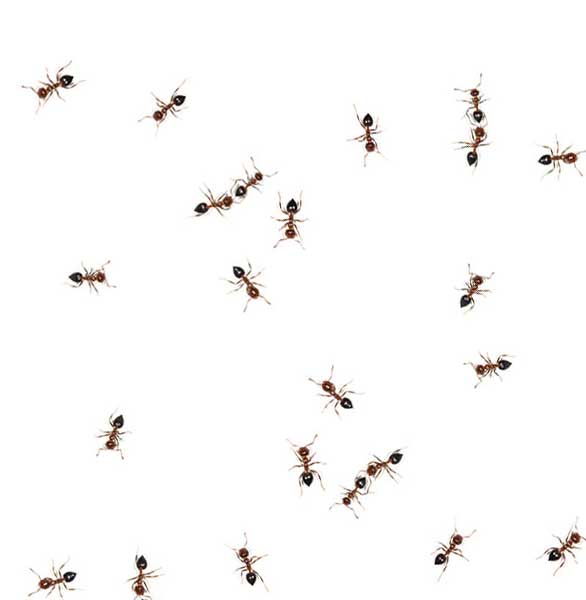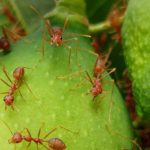Welcome To Our Ant Learning Center
AntsWhen you think of annoying pests, ants probably come to mind. That’s because you don’t just see one ant — you see dozens or maybe even hundreds at a time. Ants are a common pest that can easily cause havoc in your home or business. They love food and can ruin a picnic or party as well. There are more than 12,000 species of ants in the world. Interestingly, ants are most closely related to bees and wasps.
(Formicidae Latreille)
Description
The bodies of ants are hard and covered with armor called an exoskeleton. Most ants are either red or black, although some can be brown or yellow. They are typically 1/3″ to 1/2″ long and have six legs. Ants have large heads with a slender, oval abdomen and a small waist. They also have compound eyes, powerful jaws, and elbowed antennae. Some (like males and queens) have wings, but most do not.

Additional Information
Habits & Behavior
 Ants are social insects that live in colonies. These colonies include queens, male drones, and workers. They each have distinct duties. Queens are the ones that lay eggs and help with feeding and grooming. Each colony has at least one queen. While any female ant can become queen, not all do. Many female ants are workers that gather food, care for the larvae, and build tunnels. They are sterile and do not compete with the queen. Larger workers with well-developed mandibles are called soldiers.
Ants are social insects that live in colonies. These colonies include queens, male drones, and workers. They each have distinct duties. Queens are the ones that lay eggs and help with feeding and grooming. Each colony has at least one queen. While any female ant can become queen, not all do. Many female ants are workers that gather food, care for the larvae, and build tunnels. They are sterile and do not compete with the queen. Larger workers with well-developed mandibles are called soldiers.
Males do not participate in colony activities. Their sole job is to mate with the queens. Males are fed and cared for by the workers.
Reproduction
The life cycle of the ant encompasses four stages: egg, larva, pupa, and adult. This life cycle spans approximately 8-10 weeks. The queen spends her life laying eggs. The workers are females and do the work of the colony, with larger individuals functioning as soldiers who defend the colony. At certain times of the year, many species produce winged males and queens that fly into the air and mate. After mating with queens, the males will die.
The eggs are extremely small and can vary in shape, but tend to be oval and transparent. Ants lay fertilized and unfertilized eggs. Interestingly, unfertilized eggs hatch out males, while fertilized eggs become females. The eggs can take 7-14 days to hatch.
Upon hatching, the ant is a soft, legless larva. The larvae later turns into a pupa, which resembles the adult. However, it is soft and white, and does not move. It then takes 6-8 weeks longer for the egg to develop into an adult.
Food
Ants are omnivorous, which means they eat pretty much everything. However, their favorite foods are primarily eating other insects. They especially enjoy the milk of aphids, insect eggs, plant sap, and sweet fruits. When ants come into our homes, they will eat whatever we eat. So if you have sweets and meats lying around, they will eat them. They also enjoy pet food (such as dog and cat food) and fats.
Queen ants need a lot of nutrients. Sometimes she will eat her own eggs to survive until the worker ants become adults. In extreme cases, the queen may resort to cannibalism to survive.
Above all, ants need water to survive. If necessary, they will travel a long distance in search of it. This is usually why homeowners tend to find ants in kitchens or bathrooms. They may also be found in yards around sources of water.
Signs
The most common sign of an ant infestation is the presence of ants. You’ll likely see a huge group of them walking inside or outside your home. You might see a trail of them or ant mounds outside your home. Ant wings around doorways and window ledges are also signs of ant activity.
Dangers
While all ants have the ability to bite and sting, very few actually do. Some ants such as fire ants have venomous stings that can be painful to humans and pets. Ants are more likely to be an annoyance because they appear in large numbers, although they can cause allergic reactions in some people.
More than likely, ants cause damage to their surroundings. Ants can infest and short-circuit electrical equipment. Ants can wreak havoc on yards by affecting the landscaping. They may disturb roots, bury plants, and build anthills in the lawn. They can destroy walls and other structures with their nests. Ants can also contaminate and destroy agricultural products and stored foods.
Times their body weight that ants can carry
10-50
Number of ants species in the world
12,000
possible number of ants in some colonies
1 Mill +
Sets of legs
an ant has
3
GET A FREE CONSULTATION TODAY!
Get a FREE Consultation

